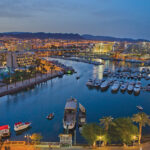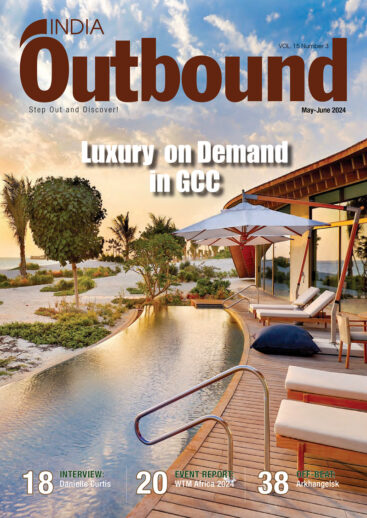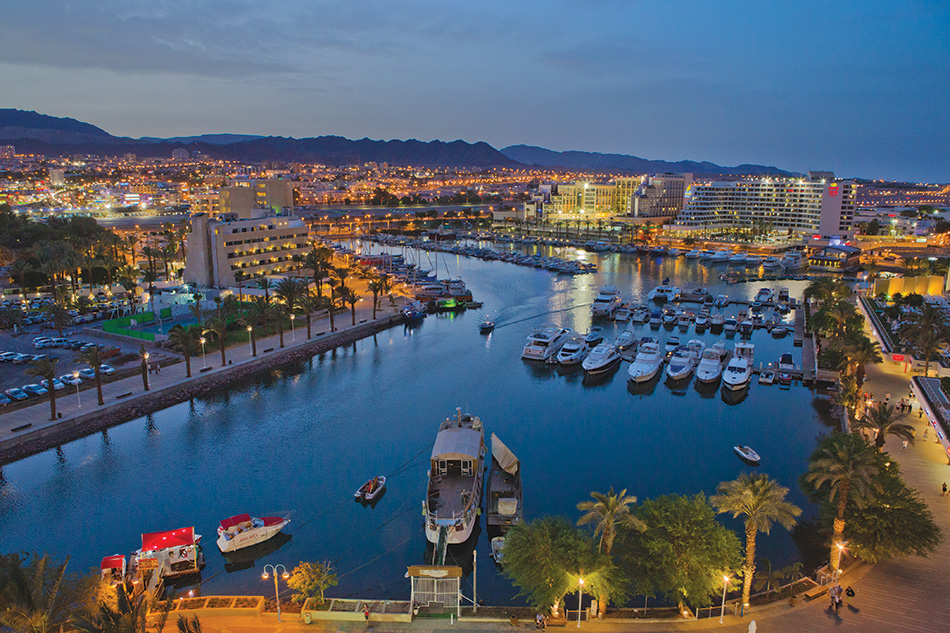
Enjoy breathtaking views of Eilat any time of the day (PC: Israel Tourism)
Even if there aren’t any casinos here, Eilat still revels in its moniker of ‘Las Vegas of Israel’. Located on the southern tip of Israel, about 375 km south of Tel Aviv, Eilat has the wellearned reputation of being the hip-town of Israel where tourists, especially the younger ones, head for its theatres, live music and all-night parties, besides lazying on the magnificent beaches of the Red Sea.
With dazzlingly lit streets, colourful markets and sounds of laughter everywhere, it is difficult to imagine that this pretty little place that nestles in the northern tip of the Red Sea was once a strategic military outpost. “Yes, ships from Africa and Asia including those laden with spices and condiments from India too, also dropped anchor here,” informed Efrain Katzir, our local Israeli friend.
But matters of trade and commerce were far from our minds as we had just finished with a date with the likes of Elvis Presley, Marilyn Monroe, and Michael Jackson in a dazzling Broadway-like show. And through that, teleported to the original ‘Sin City’, Las Vegas, with the dashing young hero of the show. His meeting with many iconic Hollywood stars, together with magicians, jugglers, rollerskaters, ventriloquists, acrobats and dancers, all contributed to the magic of his life journey. And through him, ours!
The short walk from the theatre back to our hotel had let us revel in the magic of Eilat that has been ranked on the sixth position out of 52 places to visit by a major US daily in its 2019 list. And Eilat’s attraction is spreading fast to many other countries, including Russia and India, as more and more Indian tourists begin to club it with Bethlehem, Tel Aviv and Jerusalem.
“The fact that Eilat is tax-free lures many holiday makers to keep coming back for more,” Katzir had told us the previous evening as we were driving through the 12,000 sqkm Negev Desert, enjoying the dusty yet dramatic vignettes that the landscape kept opening out for us.
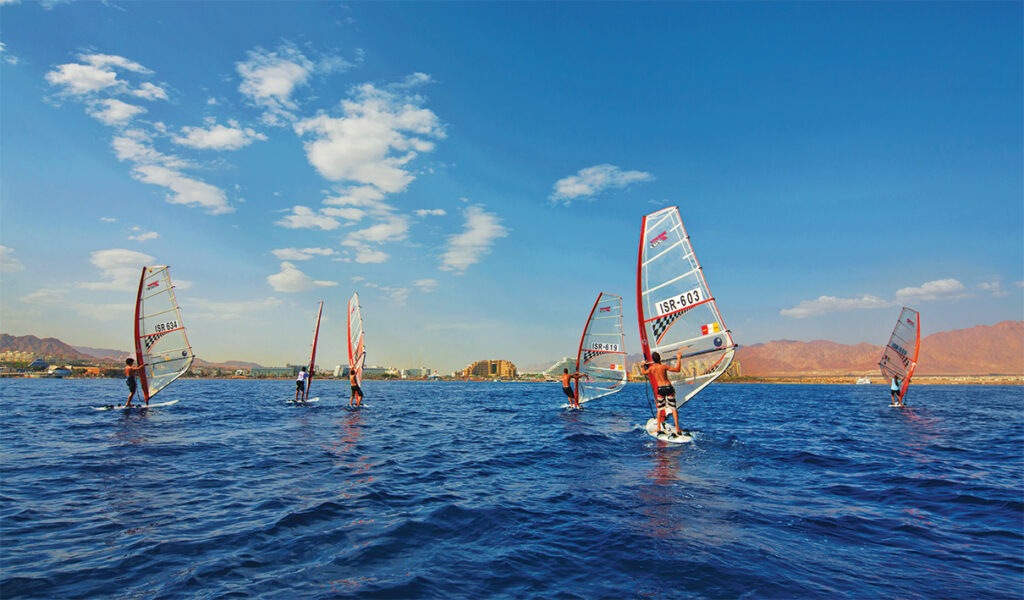
Sailboarding is a popular activity here (PC: Israel Tourism)
It was a bright sunny morning as we sat enjoying a boat ride on the waters of the Red Sea. Are the waters really red, we wondered admiring the clear blue-green expanse. “It is the special algae growing under the water that show up as a reddish-brown tinge on the surface, especially from a distance,” says Katzir, as we moved towards the underwater marine observatory that lies at the heart of Eilat’s piece de resistance, its coral reef.
A little walk over a bridge took us to the white-hued tower that stands offshore, a short distance from the mainland. Taking an elevator, we went 12m below the surface to have a first-hand view through huge glass windows of not just the spectacular coral reefs but also over 800 varieties of fish, including sharks, turtles, stingrays and even sea snakes.
Established in 1975, this Underwater Observatory, is designated a nature reserve and there is a diving team that maintains the coral reef by removing debris from corals and mending the broken ones, while keeping predators away.
It is not just at the Observatory that one can watch the abundant marine life of the Red Sea. The floating pier at Dolphin Reef allows visitors to watch the Black Sea bottlenose dolphins as they play around and swim alongside humans.

The Underwater Observatory opens up picturesque vistas inside the Red Sea (PC: Israel Tourism)
Pretty hut-like structures including a kiosk for foodies and those enjoying their drinks set the mood as the local workers give a complete low-down on snorkelling and interactions with the sea friendly sea creatures.
Those interested in snorkelling are given detailed instructions complete with a trial session. And only when a person feels confident that she is allowed to dive along with an instructor to guide visitors into the waters to have an up, close and personal experience with the dolphins.
Later, as I sat under the shade of a tree watching a cat looking around for some goodies, a visitor from Jerusalem told me that dolphins are wild and not trained to perform here. They live like they do in any natural habitat of theirs. ‘‘That’s the best thing I like about this place, that dolphins interact with visitors only when they want to. And given the fact that they are such friendly creatures they invariably do,” he says. Dolphins, he goes on to add, are not just counted among the most intelligent mammals after humans but also ones with a good memory.
A short drive from Eilat, on the way to the Egyptian border post, took us to the Red Canyon that incidentally gets its name from the phenomenon which occurs when sunlight hits a reddish rock that lines the canyon, giving it an intense auburn hue. Perfect for hikers and nature lovers, a well-marked trail guides visitors towards this redtinged rock of the canyon offering great views of the arid mountainous landscape.
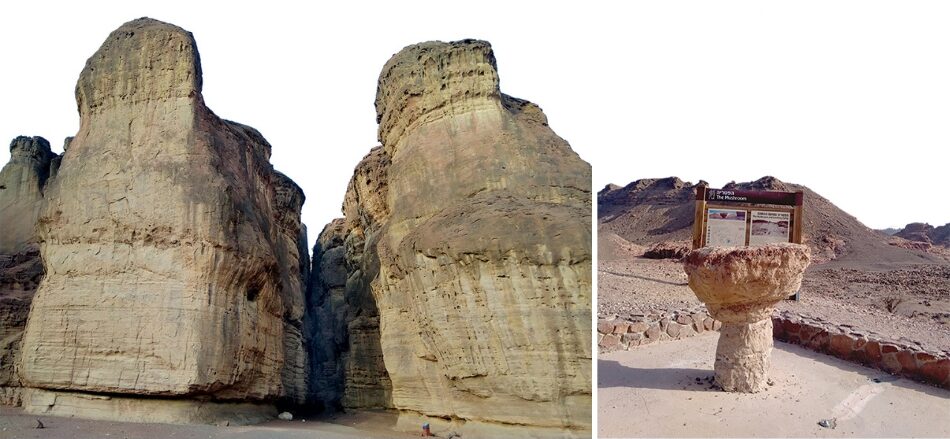
The naturally formed Mushroom Rock (Left) and Solomon’s Pillars at Timna Valley (PC: Purnima Sharma)
The southern part of Israel unveils many such unusual gems, dramatic stone formations and, yes, stretches of sand that seem to change colour at every turn, from red to yellow, orange, grey, dark brown and even black.
It was only a matter of time before we reached the Timna Valley, that is believed to have once housed an ancient coppermining site. As we admired what seemed like amazing designs hewn into the rock face, two almost twin-like ‘structures’ called Solomon’s Pillars came into view. These naturally shaped rock formations that are almost 300 m high and 130 m wide, are believed to go back to the time of the wise Biblical monarch King Solomon.
With the help of bicycle tours available here, visitors can also see another peculiarly shaped rock called ‘The Mushroom’.
A little ahead, a drive up into the mountains took us towards what has been described as Israel’s Grand Canyon, the Makhtesh Ramon. As we stood admiring this amazing natural phenomena, steep rocky walls encircling a valley that makes it appear like an enclosed giant bowl, Katzir mentioned that the word ‘makhtesh’ comes from the Hebrew word which means ‘crater’.
‘‘However, unlike the craters we are familiar with or have studied about, this one is believed to have been formed by the waters of the ancient rivers called Ramon and Ardon,’’ he said as we watched, fascinated by the play of colours created by the dimming sun light on the rock surface.








